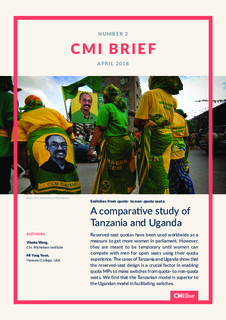| dc.contributor.author | Wang, Vibeke | |
| dc.contributor.author | Yoon, Mi Yung | |
| dc.date.accessioned | 2018-05-09T14:00:45Z | |
| dc.date.available | 2018-05-09T14:00:45Z | |
| dc.date.issued | 2018-04-01 | |
| dc.identifier | oai:www.cmi.no:6512 | |
| dc.identifier.citation | Bergen: Chr. Michelsen Institute (CMI Brief no. 2) 4 p. | |
| dc.identifier.issn | 0809-6732 | |
| dc.identifier.uri | http://hdl.handle.net/11250/2497842 | |
| dc.description.abstract | Reserved-seat quotas have been used worldwide as a measure to get more women in parliament. However, they are meant to be temporary until women can compete with men for open seats using their quota experience. The cases of Tanzania and Uganda show that the reserved-seat design is a crucial factor in enabling quota MPs to make switches from quota- to non-quota seats. We find that the Tanzanian model is superior to the Ugandan model in facilitating switches.
This CMI Brief is based on the article “Recruitment Mechanisms for Reserved Seats for Women in Parliament and Switches to Non-Quota Seats: A Comparative Study of Tanzania and Uganda” accepted for publication in Journal of Modern African Studies December 2017. | |
| dc.language.iso | eng | |
| dc.publisher | Chr. Michelsen Institute | |
| dc.relation | CMI Brief | |
| dc.relation | 2018:2 | |
| dc.relation.ispartof | CMI Brief | |
| dc.relation.ispartofseries | CMI Brief no. 2 | |
| dc.relation.ispartofseries | CMI Brief vol. 17 no. 2018:2 | |
| dc.relation.uri | https://www.cmi.no/publications/6512-switches-from-quota-to-non-quota-seats | |
| dc.subject | Quota- to Non-Quota Seats | |
| dc.subject | Women in Parliament | |
| dc.subject | Tanzania | |
| dc.subject | Uganda | |
| dc.title | Switches from quota- to non-quota seats: A comparative study of Tanzania and Uganda | |
| dc.type | Report | |
